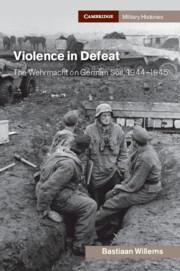Book contents
- Violence in Defeat
- Cambridge Military Histories
- Violence in Defeat
- Copyright page
- Contents
- Figures
- Maps
- Tables
- Acknowledgements
- Chronology of Events
- Abbreviations
- Introduction
- 1 Regionality and Total War in East Prussia
- 2 Eastern Front Battles on German Soil
- 3 The City As a Fortress Community
- 4 Redefining Königsberg: Historical Continuity in Practice
- 5 The Evacuation of East Prussia
- 6 Königsberg as a Community of Violence
- Conclusion
- Appendices
- Bibliography
- Index
3 - The City As a Fortress Community
Published online by Cambridge University Press: 12 February 2021
- Violence in Defeat
- Cambridge Military Histories
- Violence in Defeat
- Copyright page
- Contents
- Figures
- Maps
- Tables
- Acknowledgements
- Chronology of Events
- Abbreviations
- Introduction
- 1 Regionality and Total War in East Prussia
- 2 Eastern Front Battles on German Soil
- 3 The City As a Fortress Community
- 4 Redefining Königsberg: Historical Continuity in Practice
- 5 The Evacuation of East Prussia
- 6 Königsberg as a Community of Violence
- Conclusion
- Appendices
- Bibliography
- Index
Summary
This chapter brings the different groups of actors together in the environment in which they would experience the final months of the war: Festung Königsberg. Establishing the role cities played during wartime, it reconstructs how the fortress strategy came into being. It then explores how the new balance of power in fortresses manifested itself and how the fortress strategy was perceived by those ordered to defend them. During the Soviet 1944 summer offensive, Operation Bagration, the strategy proved to be a failure, yet the High Command persisted with it as the Wehrmacht was forced back onto German soil. After analysing why the strategy was retained on home soil, this chapter examines the working relationship between the military and the Party in these fortresses. The origins and nature of this relationship had significant consequences for the everyday rule of the besieged fortress. Both Party and Army demanded final authority in Königsberg, but it was ultimately claimed by the latter. Factors such as personal standing, reputation, and commitment among the different groups all shaped local dynamics at the fortress command and shaped the organisation of the city’s defence and evacuation.
Keywords
- Type
- Chapter
- Information
- Violence in DefeatThe Wehrmacht on German Soil, 1944–1945, pp. 115 - 157Publisher: Cambridge University PressPrint publication year: 2021

